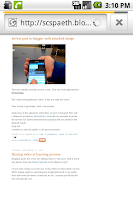 I've been programming my phone to collect data from sensor and control motors connected to the Lego NXT brick using AppInventor. I am motivated to invest this effort because my students find the Lego robotics connection motivating and engaging. The picture shows how I am able to capture browsing of the blog post about Ariel using the program to control a simple robot she created. I see them doing science, technology, engineering and math because they want to explore robot control.
I've been programming my phone to collect data from sensor and control motors connected to the Lego NXT brick using AppInventor. I am motivated to invest this effort because my students find the Lego robotics connection motivating and engaging. The picture shows how I am able to capture browsing of the blog post about Ariel using the program to control a simple robot she created. I see them doing science, technology, engineering and math because they want to explore robot control.This is a very powerful combination of prototyping and research tools. So far, I have focused on the development of tools rather than capturing high quality images of the interface. So, despite the low quality, I have simply used the iSight camera, a small digital camera or even an iPhone to snap photos of the display on my Android phone. The images show finger prints on the screen, and reflections and strange colors, ... But this weekend I generated some results that deserve better representation. So I re-searched for ways to capture screens of Android phones. Gary LaTraille at AbsolutelyAndroid surveyed several methods for capturing Android screens and recommended the Dalvik Debug Monitor (DDMS). It is included in the Android SDK but I had not taken the time to learn how to use it.
I put the Android SDK in the MyApps folder of my MLTI laptop and clicked on the DDMS application in the "Tools" folder. The DDMS does much, much more than screen capture but I can block out most of those distractions. I wonder whether the complexities might overwhelm some middle school students.


1 comment:
Yes, I know that Apple phones make it much easier to capture a screen shot and share it. But programming an app to collect sensor values and then control motors in response to those values is much, much more difficult on an Apple phone.
So, I use an eWaste Apple phone when it makes sense and Android when I want to have more control.
Post a Comment